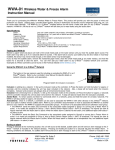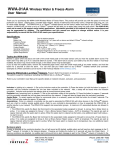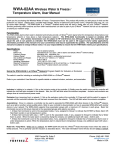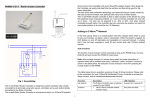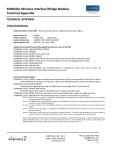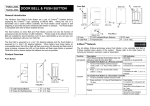Download Z-Wave Everspring SP103 Motion Detector Manual
Transcript
Choosing A Mounting Location SP103 MOTION DETECTOR The recommended position for a Motion Detector is in the corner of a room mounted 2m from the floor. At this height, the detector will detect movement up to 6-12m depending on adjustment. (FIGURE 2a) Also, in this position, the 100 degrees fan-shaped detection pattern can normally offer greater protection than mounting on a flat wall. Before selecting a position for a Motion Detector the following points should be noted: TM The Motion Detector is a Z-Wave enabled device and is fully compatible with any TM TM TM Z-Wave enabled network. Z-Wave enabled devices displaying the Z-Wave logo can also be used with it regardless of the manufacturer, and ours can also be TM used in other manufacturer’s Z-Wave enabled networks. This Motion Detector is controllable to our modules, such as On/Off Module AN135 and Lamp Module AD130. Inclusion of this Motion Detector on other manufacturer’s Wireless Controller menu allows remote turn-on of connected modules and their connected lighting when the Detector is triggered. Z-Wave nodes in the system also act as repeaters if they support that function. 1. Do not position the detector facing a window or direct sunlight. Motion Detectors are not suitable for use in conservatories or draughty areas. 2. Do not position the detector directly above or facing any source of heat, eg: fires, radiators, boiler etc. 3. Where possible, mount the detector so that the logical path of an intruder would cut across the fan pattern rather than directly towards the detector.(FIGURE 2b) The Motion Detector is designed to detect movement in a protected area by detecting changes in infra-red radiation levels caused, for example, when a person moves within or across the devices field of vision, a trigger radio signal will be transmitted. (M) 10 8 6 4 2 Adding to Z-WaveTM Network 0 2 4 6 In the rear casing, there is a tamper switch which is used to carry out inclusion, exclusion or association. Put a Z-WaveTM Wireless Controller into inclusion/exclusion mode, press the tamper switch on the detector to complete the inclusion/exclusion process. (FIGURE 1) The Motion Detector will stay “awake” for ten minutes when changing the status of tamper switch from being pressed to be released or from being released to be pressed to allow time for configuration. 100¢X 8 10 2.0 0 2 4 6 8 10 (M) FIGURE 2a Installation FIGURE 1 1 FIGURE 2b 1 Front Cover 2 Motion Sensor 3 Time-off Knob 1. 2. 3. Note: When the battery is connected, the LED behind the lens will be on for about 1 minute as warming-up duration until the Motion Sensor has stabilized when the LED turns OFF. Using a Phillips screwdrivers to detach the rear cover. (FIGURE 3a) Insert 2 AAA-size 1.5V batteries to the battery compartment, ensuring that correct polarity is put. (FIGURE 3b) Refit the rear cover. (FIGURE 3c) FIGURE 3a 4. red indicator LED on the Detector will illuminate and the load or the lamp plugged into the On/Off Module AN135, Lamp Module AD130 will turn ON. It implies that the unit is working properly. 4 Battery 5 Rear Cover 6 Tamper Switch FIGURE 3b Time-off knob controls how long the connected load or lamp will stay on after the motion has been detected. It is set from 5 seconds to 12 minutes. “T” means 5 seconds, while “+” is 12 minutes. After the expiry of preset time-off, the Detector will turn OFF the load or the lamp plugged into the On/Off Module AN135, Lamp Module AD130. The red indicator LED on the load or the connected lamp will be off too. FIGURE 3c Hold the rear cover in position and mark the two mounting holes. Drill the holes, insert the plastic wall plugs and screw the rear cover to the wall using the screws supplied. Offer the Detector up to the rear cover using screws as originally supplied. (FIGURE 4) 2. When the tamper switch is pressed, the unit will enter normal mode. Upon motion being sensed, the Detector will turn ON the load or the lamp plugged into the On/Off Module AN135, Lamp Module AD130. After the elapse of preset time-off, the Detector will turn OFF the load or the lamp plugged into the On/Off Module AN135, Lamp Module AD130. In normal mode with the tamper switch being pressed, the red indicator LED on the Detector will not illuminate to conserve battery life when the detector is triggered, (unless the battery is low). FIGURE 4 Note: After removing batteries, wait for 5 seconds to refit batteries. 3. By pressing the tamper switch for more than 5 seconds, and then release it. The Detector will send an alarm command (ALARM_REPORT, Alarm Type == 0x01, Alarm Level == 0x11) to the Module. The load or the lamp plugged into the On/Off Module AN135 or Lamp Module AD130 will flash for 10 seconds. Operation Advanced Operation 1. With the tamper switch not being pressed, the unit enters test mode, which allows the user to make a test. When the movement has been detected, the 2 The following information is for someone that has some experience setting up a Z-Wave system or someone that has computer software running a Z-Wave controller. Troubleshooting Enabling/Disabling Power Saving Function (for testing) When no movement has been detected for 10 seconds, the SP103 will enter the power saving mode. It can be disabled or enabled power saving function by setting Configuration Parameter # 3. This parameter can be configured with the value of 0 through 127, where 0 means power saving being enabled and others mean power saving being disabled. PS : As long as the batteries have been refitted, the Detector will enable the power saving function automatically. Symptom Cannot carry out inclusion and association Possible Cause 1. Run out of battery power 2. Check if reverse battery polarity 3. Check if the detector is out of order Cannot control the connected modules 1. 2. Configuring the Phase Level of ON Command The detector not working The Configuration parameter that can be used to adjust the phase level of ON command is transmitted is Configuration Parameter # 1. This parameter can be configured with the value of 0 through 127. Value Value Value 1. 2. 3. 0: Set Device OFF(0x00) 1-99: Set Device On (1-99) 100-127: Set Device On to the last phase (0xFF) 4. Run out of battery power Check if the detector is out of order Run out of battery power Check if the mounting location is proper Check if the detector is mounted above a radiator or heater Check if the detector is out of order Note: 0xFF means the device will be on to the last phase before the device was turned off. Wakeup Command Class Recommendation 1. Replace a new battery 2. Refit the battery with correct polarity 3. Ensure the detector is working properly 1. Replace a new battery 2. Ensure the detector is working properly 1. Replace a new battery 2. Reposition its mounting location 3. Remove the source of interference or reposition its mounting location 4. Ensure the detector is working properly Specifications SP103 will send a Wakeup Notification Command if it has been included into a Z-Wave network. The prerequisite is the connected Z-Wave controller needs to emit a node ID and wakeup time interval to the Detector. Battery 1.5V AAA size x 2 Range Up to 100 meters line of sight Warm Up Time PIR Detection Coverage The SP103 will wake up every 4 hours (default) and resend the Wakeup Notification Command unless configured for another time interval. The SP103 will stay awake for 10 seconds and then go back to sleep to conserve battery life. Frequency Range About 1 minute Up to 10m x 100° (at 2m mounting height & below 20°C) 908.42 MHz (US) / 868.42 MHz (EU) *Specifications are subject to change without notice A501110874R The time interval between Wakeup Notification Commands can be adjusted if you have a device in which that is supported. Refer to that device’s instructions. 3 If electrical appliances are disposed of in landfills or dumps, hazardous substances can leak into the groundwater and get into the food chain, damaging your health and well-being. When replacing old appliances with new once, the retailer is legally obligated to take back your old appliance for disposal at least for free of charge. Federal Communication Commission Interference Statement This equipment has been tested and found to comply with the limits for a Class B digital device, pursuant to Part 15 of the FCC Rules. These limits are designed to provide reasonable protection against harmful interference in a residential installation. This equipment generates, uses and can radiate radio frequency energy and, if not installed and used in accordance with the instructions, may cause harmful interference to radio communications. However, there is no guarantee that interference will not occur in a particular installation. If this equipment does cause harmful interference to radio or television reception, which can be determined by turning the equipment off and on, the user is encouraged to try to correct the interference by one of the following measures: Reorient or relocate the receiving antenna. Increase the separation between the equipment and receiver. Connect the equipment into an outlet on a circuit different from that to which the receiver is connected. Consult the dealer or an experienced radio/TV technician for help. This device complies with Part 15 of the FCC Rules. Operation is subject to the following two conditions: (1) This device may not cause harmful interference, and (2) this device must accept any interference received, including interference that may cause undesired operation. FCC Caution: Any changes or modifications not expressly approved by the party responsible for compliance could void the user's authority to operate this equipment. This transmitter must not be co-located or operating in conjunction with any other antenna or transmitter. WARNING: Do not dispose of electrical appliances as unsorted municipal waste, use separate collection facilities. Contact your local government for information regarding the collection systems available. 4




